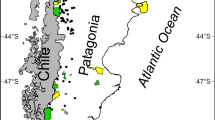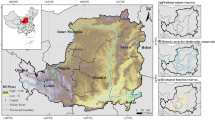Abstract
This study aimed to develop a practical approach to identify the priority areas with ecological significance along highly human disturbed coastal areas. Field surveys were used to assess and complement to the results of the remote sensing (RS)-based analysis. The RS-based biodiversity hotspot (BH) identification process was accomplished in three steps. The lands with native vegetation cover, including the national natural reserve lands, were first selected as the baseline BHs (BBHs). Then, after assigning resistance coefficients to each land use, the least accumulative cost (LAC) of the BBHs was calculated by distance analysis, while the normalized differential vegetation index (NDVI) from the Landsat Thematic Mapper was reclassified into 20 grades based on the Euclidean distance to the main anthropogenic sources. Finally, the RS-based BH identification was realized through the logistic calculation of LAC less than a series of thresholds and NDVI more than 10. While the field survey-based BH identification was through the logistic calculation between HM potential ecological risks of low to moderate and BHs acquired by NDVI-based integrated assessments. The results proved that RS-based analysis could be an important surrogate for necessary field surveys to manage BHs along coasts.




Similar content being viewed by others
References
Acosta A, Carranza ML, Izzi CF (2009) Are there habitats that contribute best to plant species diversity in coastal dunes? Biodivers Conserv 18:1087-1098
An S et al (2007) China's natural wetlands: past problems, current status, and future challenges. Ambio J Human Environ 36:335–342
Aydin S, Kucuksezgin F (2012) Distribution and chemical speciation of heavy metals in the surficial sediments of the Bakırçay and Gediz Rivers, Eastern Aegean. Environ Earth Sci 65:789–803
Balletto E, Bonelli S, Borghesio L, Casale A, Brandmayr P, Taglianti AV (2010) Hotspots of biodiversity and conservation priorities: A methodological approach. Ital J Zool 77:2–13
Bo M, Wang X, Liu X, Wang Z (2011) GIS analysis of the spatial relationship between plateau pika burrow dis-tribution and vegetation distributional patterns. Biodivers Sci 19:71–78
Broadbent EN, Asner GP, Peña-Claros M, Palace M, Soriano M (2008) Spatial partitioning of biomass and diversity in a lowland Bolivian forest: linking field and remote sensing measurements. Forest Ecol Manage 255:2602–2616
Brucet S, Poikane S, Lyche-Solheim A, Birk S (2013) Biological assessment of European lakes: ecological rationale and human impacts. Freshw Biol 58:1106–1115
Buchanan GM, Nelson A, Mayaux P, Hartley A, Donald PF (2009) Delivering a Global, Terrestrial, Biodiversity Observation System through Remote Sensing. Conserv Biol 23:499–502
Chandrasekaran S (2007) Biodiversity hotspots: Defining the indefinable? Curr Sci 92:1344–1345
Christensen JR, Nash MS, Neale A (2013) Identifying riparian buffer effects on stream nitrogen in Southeastern coastal plain watersheds. Environ Manage 52(5):1161-1176
Cooper MI, Plessis MA, Du (1998) Biodiversity hotspots in the developing world. Trends Ecol Evol 13:409
Delgado J, Barba-Brioso C, Nieto JM, Boski T (2011) Speciation and ecological risk of toxic elements in estuarine sediments affected by multiple anthropogenic contributions (Guadiana saltmarshes, SW Iberian Peninsula): I. Surficial sediments. Sci Total Environ 409:3666–3679
Deng HG, Zhang J, Wang DQ, Chen ZL, Xu SY (2010) Heavy metal pollution and assessment of the tidal flat sediments near the coastal sewage outfalls of shanghai, China. Environ Earth Sci 60:57–63
Ewers RM, Didham RK, Wratten SD, Tylianakis JM (2005) Remotely sensed landscape heterogeneity as a rapid tool for assessing local biodiversity value in a highly modified New Zealand landscape. Biodivers Conserv 14:1469–1485
Fa-neng YIN, Xue-lei W (2010) Ecological Landscape Planning of the Four-Lake Basin Based on Accumulative Minimum Resistance Model. J Huazhong Agri Univ 29:231–235
Fang SB, Zhang XS, Jia XB, An SQ, Zhou CF, Xu C (2009) Evaluation of potential habitat with an integrated analysis of a spatial conservation strategy for David's deer, Elaphurus davidians. Environ Monit Assess 150:455–468
Fang SB, Xu C, Jia XB, Wang BZ, An SQ (2010) Using heavy metals to detect the human disturbances spatial scale on Chinese Yellow Sea coasts with an integrated analysis. J Hazard Mater 184:375–385
Fang SB, Jia XB, Yang XY, Li YD, An SQ (2012) A method of identifying priority spatial patterns for the management of potential ecological risks posed by heavy metals. J Hazard Mater 237–238:290–298
Fang S, Pang H, Zheng Z (2013) Integrating Landuse with Heavy Metals as Indicators of anthropogenic Disturbances on Chinese Yellow Sea Coast. World Acad Publish 3:9–18
Fox NJ, Beckley LE (2005) Priority areas for conservation of Western Australian coastal fishes: a comparison of hotspot, biogeographical and complementarity approaches. Biol Conserv 125:399-410
Gjerde I, Sætersdal M, Blom HH (2007) Complementary Hotspot Inventory – A method for identification of important areas for biodiversity at the forest stand level. Biol Conserv 137:549–557
Hakanson L (1980) An ecological risk index for aquatic pollution control.a sedimentological approach. Water Res 14:975–1001
Kachelriess D, Wegmann M, Gollock M, Pettorelli N (2014) The application of remote sensing for marine protected area management. Ecol Indic 36:169–177
Kim J, Shin JR, Koo TH (2009) Heavy metal distribution in some wild birds from Korea. Arch Environ Con Tox 56:317-324
Kumar TS, Mahendra RS, Nayak S, Radhakrishnan K, Sahu KC (2012) Identification of hot spots and well managed areas of Pichavaram mangrove using Landsat TM and Resourcesat-1 LISS IV: An example of coastal resource conservation along Tamil Nadu Coast, India. J Coast Conserv 16:1–12
Lascelles BG, Langham GM, Ronconi RA, Reid JB (2012) From hotspots to site protection: Identifying Marine Protected Areas for seabirds around the globe. Biol Conserv 156:5–14
Leroux SJ, Kerr JT (2013) Land Development in and around Protected Areas at the Wilderness. Frontier Focus Autism Other Develop Disabilities 20:213–222
Lück-Vogel M, O’Farrell PJ, Roberts W (2013) Remote sensing based ecosystem state assessment in the Sandveld Region, South Africa. Ecol Indic 33:60–70
Manfred L, Amanda L, Asaph WC, Moira W (2009) Effects of Land Use on Threatened Species. Conserv Biol J Soc Conserv Biol 23:294–306
Mcwethy DB et al (2013) A conceptual framework for predicting temperate ecosystem sensitivity to human impacts on fire regimes. Glob Ecol Biogeogr 22:900–912
Myers N (1988) Threatened biotas: "Hot spots" in tropical forests. Environmentalist 8:187–208
Myers N (1990) The biodiversity challenge: Expanded hot-spots analysis. Environmentalist 10:243–256
Myers N (2003) Conservation of biodiversity: How are we doing? Environmentalist 23:9–15
Myers N, ., Mittermeier RA, Mittermeier CG, Fonseca GA, Da, Kent J,. (2000) Biodiversity hotspots for conservation priorities. Nature 403:853-858
Newton A, Carruthers TJB, Icely J (2012) The coastal syndromes and hotspots on the coast. Estuar Coast Shelf Sci 96:39–47
Pan K, Wang WX (2012) Trace metal contamination in estuarine and coastal environments in China. Science of the Total Environment 421–422:3–16
Pascual LL, Luigi M, Alessandra F, Emilio B, Luigi B (2011) Hotspots of species richness, threat and endemism for terrestrial vertebrates in SW Europe. Acta Oecol 37:399–412
Reese DC, Brodeur RD (2006) Identifying and characterizing biological hotspots in the northern California. Current Deep Sea Res Part II Topical Studies Oceanography 53:291–314
Reid WV (1998) Biodiversity hotspots. Trends Ecol Evol 13:275–280
Shi H, Singh A (2002) An assessment of biodiversity hotspots using remote sensing and GIS. J Indian Soc Remote Sensing 30:105–112
Stankovic S, Jovic J (2012) Health risks of heavy metals in the mediterranean mussels as seafood. Environ Chem Lett 10:119-130
Svancara LK, Scott JM, Loveland TR, Pidgorna AB (2009) Assessing the landscape context and conversion risk of protected areas using satellite data products. Remote Sens Environ 113:1357–1369
Tian Z, Fang SB, Yin CS, Zhang YJ, Shu-Qing AN, Cheng H (2013) Evaluation of spatial correlation between landscape pattern changes and heavy metals spatial interpolation analysis along Yancheng coast. J Shanghai Ocean Univ 22:912–921
Veech JA (2003) Incorporating socioeconomic factors into the analysis of biodiversity hotspots. Appl Geogr 23:73–88
Wang XH, Zou XQ, Wen-Jin YU (2007) Heavy metal contamination in coastal sediments of Wanggang, Jiangsu Province. J Agro-Environ Sci
Weber G, Robaye G, Delbrouck JM, Roelandts I, Dideberg O, Bartsch P, Pauw MCD (2009) Avian conservation priorities in a top-ranked biodiversity hotspot. Biol Conserv 143:992–998
Wiens J et al (2009) Selecting and conserving lands for biodiversity: The role of remote sensing. Remote Sens Environ 113:1370–1381
Xu C, Sheng S, Zhou W, Cui L, Liu M (2011) Characterizing wetland change at landscape scale in Jiangsu Province, China. Environ Monit Assess 179:279–292
Xue D Y (2001) Assessmen of biodiversity hot-spots in Yancheng marshes, Jiangsu Province, China, Project of Wetland Biodiversity Conservation and Sustainable Use in China
Yu K (1996) Security patterns and surface model in landscape ecological planning. Landsc Urban Plan 36:1–17
Zaharescu DG, Hooda PS, Soler AP, Javier F, Burghelea CI (2009) Trace metals and their source in the catchment of the high altitude Lake Respomuso, Central Pyrenees. Sci Total Environ 407:3546–3553
Acknowledgement
This work is supported by the National 973 Key Project of Basic Science Research (no. 2012CB430400), the Natural Scientific Foundation of China (no. 41101172, 41201179), and Shanghai Universities First-class Disciplines Project of Fisheries.
Author information
Authors and Affiliations
Corresponding author
Rights and permissions
About this article
Cite this article
Li, N., Yang, W., Xu, L. et al. Two comparative approaches to identify the conservation priority areas impacted by heavy metals on Yellow Sea coasts. J Coast Conserv 21, 177–188 (2017). https://doi.org/10.1007/s11852-016-0488-y
Received:
Revised:
Accepted:
Published:
Issue Date:
DOI: https://doi.org/10.1007/s11852-016-0488-y




